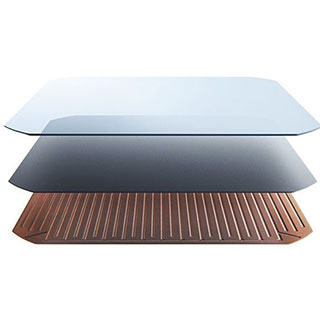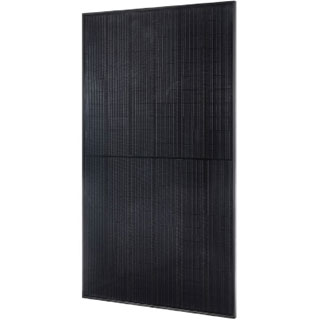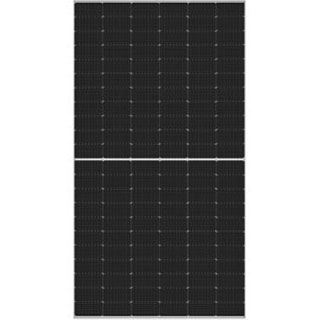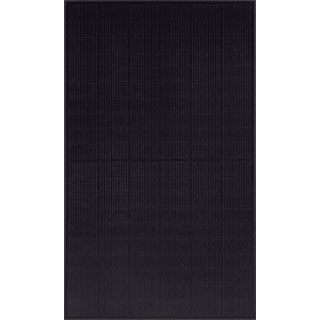Best solar panels in 2024
Our 4 top picks for residential solar panels

The ConsumerAffairs Research Team conducted an unbiased evaluation of top solar panel brands on the market. To pick the best, we looked for high efficiency ratings, comprehensive warranties and good customer reviews.
At the time of publishing, all our top picks have a maximum efficiency rating of at least 21.4% and a power production warranty of at least 25 years.
Our editors’ top picks
- Our pick for black roof panels: Maxeon
- Our pick for guaranteed output: Panasonic
- Our pick for flexible panel options: LONGi Solar
- Our pick for wind resistance: QCells
Compare our top 4 solar panel brands of 2023
Our picks for best solar panel brands are Maxeon, Panasonic, LONGi and QCells. Though Maxeon is our top pick for black roof panels, Panasonic is another great option (and could be easier to find in 2023). LONGi might be better for more powerful systems, but QCells is often a better value.
| Maxeon | Panasonic | LONGi Solar | QCells | |
|---|---|---|---|---|
| Our pick for | Black roof panels | Guaranteed output | Flexible options | Good wind resistance |
| Monocrystalline | ✔ | ✔ | ✔ | ✔ |
| Estimated cost per watt | $3.48 to $4.10 | $2.61 to $3.45 | $2.77 to $5.75 | $2.32 to $3.16 |
| Max efficiency | 22.6% | 22.2% | 21.5% | 21.4% |
| Approximate wattage | 400 W | 350-430 W | 410-550 W | 370-585 W |
| Warranty | 40 years | 25 years | Up to 30 years | Up to 30 years |
| Installers | SunPower, Greentech Renewables | Sunlux, ShopSolar, Green Home Systems and others | ShopSolar, Green Home Systems and others | Green Home Systems, Sunlux, Elevation and others |
| LEARN MORE | LEARN MORE | LEARN MORE | LEARN MORE |
More details on our top solar panel picks
We gave preference to monocrystalline panels because they're the most powerful type of solar panels. However, they're also the most expensive. Robert Flores, a solar expert at the University of California, Irvine Advanced Power and Energy Program, calls them the “Cadillac of solar panels.” He also gave us some impartial guidance on choosing quality solar panels (more on that below).
Our pick for black roof panels: Maxeon
|
|
Maxeon sells three series of solar panels. You can choose from the M Series, X Series and U Series. The M Series panels — the most expensive — have the highest performance. X Series panels have a lower output and cost less, and the U Series is considered the budget option.
Why we picked it
What to consider
What people say
“Solar technology continues to evolve and improve, I believe it is important to be as close to the leading edge when making purchasing decisions seeing these panels will be utilized for many years,” he added.
Another customer in Texas highlighted SunPower’s monitoring app, which works with Maxeon and other panels available through the company.
Our pick for guaranteed output: Panasonic
|
|
Panasonic EverVolt panels are made of one crystalline layer sandwiched between two thin-film panels. This allows for more light to filter from the top surface through the absorbent middle and to the lower surface. Depending on the model, Panasonic guarantees 86% to 92% of the expected power output (wattage) for 25 years.
Why we picked it
What to consider
What people say
Another customer, Betty in California , chose Panasonic solar panels because a friend had used them, and she liked them.
“I had done some comparison, and they came up with the best overall deal for what I was looking for,” she said. “So far, the panels are working great, and I have nothing but good things to say.”
Our pick for flexible options: LONGi
|
|
LONGi has specialized in manufacturing high-efficiency monocrystalline solar cells and PV modules since 2000. It launched its mono-PERC modules — featuring integrated PERC technology on monocrystalline silicon and low light degradation — in 2016.
Why we picked it
What to consider
What people say
Our pick for good wind resistance: QCells
|
|
QCells panels are known for their innovation. They offer high-quality panels with advanced technology, making them a popular choice for those looking for cutting-edge solar solutions. QCells’ Q.Peak Duo BLK ML-G10+ solar panels are guaranteed for 86% of their original power output after 25 years.
Why we picked it
If it snows, they can handle up to 5,400 pascals (about 113 pounds of pressure per square foot). The panels can also tolerate up to 4,000 pascals (about 84 pounds per square foot) of wind resistance.
In other words, if a lot of snow piles up on them, these panels can take the weight. The panels are also strong against heavy winds. So, even in strong storms, they are built to stay put and not get damaged.
What to consider
What people say
“Also, the panels' high power output and efficiency mean you can install fewer panels and save both money and space,” according to Alina Bradford, who wrote about how Qcells is one of the most efficient solar panels .
Ultimate guide to buying solar panels
From panel types to permits, installing a solar system involves many factors. Some companies, like SunPower, help you tackle installation, permitting paperwork and tax incentive applications. You could also buy panels from a store like ShopSolar and hire a local solar installer or certified contractors to complete the project.
Key insights
- If you can get your average energy consumption down, you’ll need fewer panels to meet your energy needs.
- The type of solar panel that’s best for your home will depend mostly on your available roof space.
- Cost per watt and estimated cost per kilowatt-hour (kWh) are the most useful metrics for comparing panels.
How to choose solar panels (and an installer)
Going solar power isn't just about slapping some panels on your roof and hoping for the best. You have to understand your home's energy needs to really compare different solar installer quotes. Plus, there might be local financial incentives and different payment options to consider.
1. Calculate your home's energy needs
“The first thing is to make sure your electrical loads are as small as can be,” according to Flores, the solar expert at UC Irvine.
How many solar panels you need depends on your household’s average energy usage. You need fewer panels if you have a low energy load. So, if you have a 20-year-old refrigerator, aging air conditioning or electric baseboard heating, it makes sense to replace those first.
A solar panel system typically costs $10,000 to $30,000 or more.
“If you think about this in terms of ROI, typically reducing your loads by installing or replacing equipment will give you a higher return,” Flores said. “If you reduce your electrical load, it reduces how much solar energy you need also.”
You should also make sure that your roof is in good enough condition to support the solar panels that you want.
2. Decide on a panel type and capacity
Solar panels with high efficiency ratings produce more power with limited space. Since polycrystalline solar panels are generally less efficient, those with limited roof space may have to go with the more expensive monocrystalline panels.
"Monocrystalline solar panels will produce the most efficiency, while polycrystalline solar panels are the most environmentally friendly,” said Andrew Meyer, CEO of Arbor, a digital energy advisor. “If you’re on a budget, you could also consider thin-film, but keep in mind they won’t last as long as the other two types.”
Good solar panels have efficiency ratings between 20% and 22%.
Pay attention to different panels' power ratings and temperature coefficients as you compare. These days, the best solar panels have an efficiency rating between 20% and 22%. This means that, under ideal conditions, 20% to 22% of sun waves that hit the panels will be converted into usable electricity.
Flores recommends the National Renewable Energy Laboratory’s PVWatts Calculator. NREL’s free online tool lets you type in your address and estimate how much electricity a solar panel can produce over a year.
3. Compare multiple solar installer quotes
It’s easy to focus on the total price when comparing solar quotes, but that’s not necessarily the most important thing to consider.
“The key thing, regardless of panel type, comes down to dollars per kilowatt-hour installed price,” Flores said. “It boils down to, What is the amount of money you’re paying for each unit of energy?”
How much you pay for each unit of power will vary from brand to brand and depends on your location.
“If you’re closer to $2 per watt, it’s almost always gonna make sense financially,” Flores said. “When you get to mid-$2s or $3s, you’re competing with just buying electricity from the utility to where it doesn’t make sense.”
It boils down to, what is the amount of money you’re paying for each unit of energy?”
Anecdotally, how much people spend on solar panels doesn’t always correlate with how well they perform. We’ve talked to plenty of happy solar customers who spent less than $15,000 on a system and disappointed ones who spent much, much more — $100,000 in some cases.
The cost to install includes an electrician to handle the wiring. The electrician connects your solar energy system to your home’s power and sets up the necessary components to convert the power from the panels to the same AC voltage as you have in your home.
In addition to solar panel costs, you should also budget for inverters, storage batteries and charge controllers. The quality of the inverter and battery can affect the quality of your overall solar power system.
» COMPARE: Best solar companies
| SunPower | Sunlux | Complete Solaria | Solar Optimum | Palmetto Solar | |
|---|---|---|---|---|---|
| Primary | Read reviews | Customer Rating 4.0 | Warranty
25 years
| Financing options
Cash, loan, lease and PPA
| |
| Primary | Read reviews | Customer Rating 4.5 | Warranty
25 years
| Financing options
Cash, loan and lease
| |
| Primary | Read reviews | Customer Rating 5.0 | Warranty
25 to 30 years
| Financing options
Cash, loan
| |
| Primary | 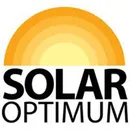 | Read reviews | Customer Rating Pending | Warranty
6-point, 25-year Warranties
| Financing options
Cash, lease, loan, PPA
|
| Primary | Read reviews | Customer Rating 3.7 | Warranty
25 years
| Financing options
Cash, loan, lease
|
4. Check credentials and licenses
Solar panel manufacturers are separated into different tiers. Tier 1 status is typically reserved for the largest manufacturers with automated protection and some degree of vertical integration. Small- to medium-scale manufacturers fall into tiers 2 or 3. Tier 1 solar panels are typically more expensive, but they’re not necessarily better in quality.
- Product certifications: Check International Electrotechnical Commission (IEC) certifications to ensure the solar panels meet international standards for performance and safety. UL 1703 is a certification from UL Solutions, indicating that the solar panels have met certain safety standards.
- Installer certifications and licenses: The North American Board of Certified Energy Practitioners (NABCEP) offers certifications and credentials for renewable energy professionals, including solar PV installers. Solar installers are also usually required to have a state contractor’s license.
5. Understand zoning and permitting
When it comes to solar panels, local zoning regulations may cover aspects such as setbacks, height restrictions and aesthetic considerations. You might have to rethink your solar plan based on local regulations. For example, Bobby in Colorado said their system “had to get a slight redesign through the city permitting stage.”
Permitting is the process of getting official approval from your local government or building department to install solar panels. It also makes sure the installation meets safety and code requirements. Some companies, like SunPower, help you tackle permitting paperwork and tax incentive applications.
You might also have to deal with a homeowners association, like one solar customer in Florida told us: “Setting up everything was easy. The biggest time it took was for my HOA to approve the architectural request for the solar panel. Once that was done, it was quick.”
» COMPARE: Find the best portable solar panels
6. Explore payment options
Paying cash for solar panels is great if you can afford it. You don’t have to worry about paying interest over time. But that’s not an option for everyone. If you’re worried about the upfront costs of going solar, you might consider leasing panels or entering a power purchase agreement (PPA).
Many people finance solar panels. A solar loan works a lot like any other type of loan — there’s an application and approval process, and you pay it back over time with interest. If you get a solar loan or lease, always ask:
- Is there a down payment?
- How much will I pay per month?
- When will monthly payments increase, and by how much?
» SOLAR PANELS: Lease vs. buy
7. Ask about warranties and guarantees
Most manufacturers offer performance and product warranties. A product warranty typically covers defects for around 10 to 12 years, while a performance warranty ensures the panel maintains a specified efficiency for 25 years or more.
It’s often worth it to pay a little more to get a better warranty. For example, when Buddy in Florida was comparing solar companies, one “came in with all the popular brand name items and a reasonable offer of $23,000, with 25-year panel warranty and 5-year labor warranty.”
Solar panels last 25 to 30 years.
Another company had “excellent brand-name panels and microinverters with a 25-year parts AND labor warranty, for $28,000,” Buddy added. “That’s a little more than I planned to spend. But I can see the value in the added labor warranty as I don’t plan to be on my own roof fixing things 20 years from now.”
Another solar customer, Michael in Las Vegas, went with a company that guarantees about 97% of its panels’ production. “So if it isn't, I can always call them on the guarantee on that. Whereas other ones, the details on those were down to 80%, so I'd lose quite a bit,” Michael said.
» MORE: Solar panel installation guide
FAQ
How much are solar panels?
A typical residential solar panel system costs anywhere from $10,000 to $30,000 or more. In general, before tax credits and incentives, most homeowners can expect to pay between $15,000 and $25,000 for a standard 6-kilowatt solar panel system, according to Alan Duncan, founder of Solar Panels Network USA, a solar panel installation company based in Denver.
The overall price varies based on the size of the system, your location, supplier and available incentives. The upfront cost of purchasing and installing solar panels can be significant, but the energy savings can offset the initial investment with a great ROI over time. You can further reduce the overall cost with tax incentives, rebates or net metering programs.
What are the different types of solar panels?
The main types of solar panels are monocrystalline, polycrystalline, thin-film and concentrated photovoltaic (PV). With all factors being equal — location, available space (roof or another dedicated area), shading, climate and natural degradation of the panels — monocrystalline and polycrystalline panels are typically the best choice for residential energy needs.
Monocrystalline solar panels tend to be more efficient than polycrystalline solar panels, and both tend to perform better than thin-film solar panels. Polycrystalline solar panels are a popular option for homes but tend to have a lower efficiency rate than monocrystalline solar panels.
- Monocrystalline solar panels: Monocrystalline solar panels are made from melted pure silicon formed into bars and cut into wafers. You can easily recognize them by their uniform dark color and rounded edges. They are more efficient and last longer than other types of panels.
- Polycrystalline solar panels: Compared with monocrystalline, polycrystalline panels have a more speckled look and bluish color. Sometimes called “multicrystalline,” these panels are made from fragments of silicon melted together to form the wafers. With more crystals in each cell, there's less freedom for the electrons to move around. This results in a lower efficiency rating of about 13% to 16%.
- Thin-film solar panels: Thin-film solar energy panels are made by layering thin solar cells on materials such as glass, metal or plastic. They're cheaper to manufacture and easier to mass-produce than crystalline-based panels. Since thin-film panels require a lot of space, they’re not ideal for residential use and are often used for commercial buildings or satellites.
- Concentrated PV cell solar panels: These panels contain a concentrated amount of photovoltaic material, making them the most efficient type of solar panel with a 41% efficiency rate. They're extremely expensive and are currently used in satellites and research labs — not residential or commercial buildings. Concentrated photovoltaic cell panels are used primarily on satellites and in research labs.
How do solar panels work?
Solar panels are special devices that use energy from the sun to make electricity. They are usually installed on rooftops.
Inside a solar panel are cells made of silicon, a material found in sand. When sunlight hits the solar panel, the silicon cells absorb the light. This creates an electric current that flows through wires in the panel.
The current travels from the solar panel wires into an inverter box. The inverter changes the current from DC to AC. DC stands for direct current — the type of electricity solar panels make. AC stands for alternating current — the kind of electricity used to power homes. From the inverter, the AC current flows into your home's electric panel. This lets you use the electricity from the sun to run lights, appliances and everything that needs power.
On very sunny days, solar panels may make extra electricity. If this happens, the extra can flow back into power lines outside. This is called feeding electricity into the grid. At night, when it's dark, solar panels stop making current. But you can still use electricity from the regular electric grid.
What does a solar panel's efficiency rating mean?
A solar panel's efficiency rating tells you how good it is at turning sunlight into electricity. The higher the efficiency rating, the more electricity the solar panel can produce from the same amount of sunlight.
A solar panel efficiency calculation is the conversion rate used to measure how much of the sun's rays a panel can convert into usable energy. Specifically, it’s the portion of sunlight that can be converted into electricity.
For example, say Panel A has an efficiency rating of 15% and Panel B has an efficiency rating of 20%. If both get exactly the same amount of sunlight in one day, Panel B will make more electricity because it converts more of that sunlight into power.
Do shade and temperature affect solar panel efficiency?
Shade can reduce the amount of electricity produced by a solar panel. That’s why you should position panels where they will receive maximum sunlight. Because solar cells are connected in a series, even just a little shade on one panel can cease solar production on all other panels. Trim your trees as needed to ensure no shade falls on any part of your solar panels.
Solar panels work best when they’re kept cool and dry. Higher temperatures can reduce a solar panel's power production by 10% to 25%.
Do solar panels require maintenance?
Although regular maintenance isn’t necessary for grid-tied systems, routine cleaning is recommended in order to remove dust, dirt and other traditional contaminants that can affect efficiency. If your area doesn’t receive rainfall, you can wipe off dust with soapy water or by hiring a cleaning service.
» GUIDE: Solar panel maintenance guide
What's the difference between on-grid and off-grid solar systems?
On-grid systems are connected to the public electricity grid and can draw from or feed into it. Off-grid systems operate independently of the grid and usually require storage solutions, like solar batteries.
» EXPLORE: Types of solar grid systems
Do solar panels increase home value?
In many cases, solar panels can increase the resale value of a home. However, it likely isn’t worth it for the increase in your home’s resale value alone.
Bottom line: Are solar panels worth it?
Solar panels are worth it for the long-term utility savings and the environmental impact. When you’re choosing a solar energy company to power your home, look for one that has a high efficiency rating to maximize the amount of power your solar system generates and a good warranty to protect you from future maintenance costs.
In terms of efficiency, brands such as Maxeon, Panasonic, LONGi, QCells, Silfab and REC are all potentially good options. We compared some of the best solar panel companies on efficiency ratings, warranty coverage, availability and reviews:
- Our pick for black roof panels: Maxeon
- Our pick for guaranteed output: Panasonic
- Our pick for flexible panel options: LONGi Solar
- Our pick for wind resistance: QCells
» MORE: Best solar phone chargers
Article sources
- EnergySage, “ What are the most efficient solar panels? Top brands in 2023 .” Accessed Sept. 25, 2023.
- EnergySage, “ Panasonic solar panels: The complete review .” Accessed Sept. 25, 2023.
- EnergySage, “ Q CELLS solar panels: The complete review .” Accessed Sept. 25, 2023.
- U.S. Department of Energy, “ Planning a Home Solar Electric System .” Accessed Sept. 25, 2023.
- National Renewable Energy Laboratory, “ Solar Cell Efficiency Table Guide .” Accessed Sept. 25, 2023.
- SolarReviews, “ LONGi is one of the top solar brands - find out why .” Accessed Sept. 25, 2023.
